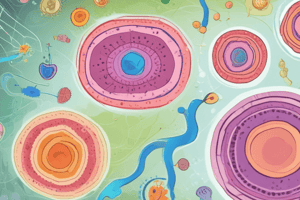Podcast
Questions and Answers
Which of the following statements accurately describes the function of the plasma membrane?
Which of the following statements accurately describes the function of the plasma membrane?
- It primarily functions as a structural support for the cell, providing shape and rigidity.
- It acts as a barrier that completely prevents all substances from entering or leaving the cell.
- It allows all substances to freely pass through, ensuring a constant exchange between the cell and its surroundings.
- It regulates the passage of substances into and out of the cell, allowing some substances to pass while restricting others. (correct)
What is the primary role of the phospholipid bilayer in the plasma membrane?
What is the primary role of the phospholipid bilayer in the plasma membrane?
- To form a selectively permeable barrier that regulates the passage of substances into and out of the cell. (correct)
- To provide structural support and rigidity to the membrane.
- To act as channels for the transport of large molecules across the membrane.
- To create a barrier that prevents the passage of all water-soluble substances.
Which of the following is NOT a function of membrane proteins?
Which of the following is NOT a function of membrane proteins?
- Acting as receptors for signaling molecules, initiating cellular responses.
- Synthesizing phospholipids for the membrane itself. (correct)
- Providing structural support and maintaining the cell's shape.
- Acting as channels for the transport of specific molecules across the membrane.
Which of the following statements accurately describes the role of the carbohydrate molecules attached to some membrane proteins?
Which of the following statements accurately describes the role of the carbohydrate molecules attached to some membrane proteins?
Which of the following represents the correct order of stages in the development of a human from a single cell?
Which of the following represents the correct order of stages in the development of a human from a single cell?
What is the primary function of the nucleus within a cell?
What is the primary function of the nucleus within a cell?
Which of the following organelles is responsible for producing energy (ATP) for the cell?
Which of the following organelles is responsible for producing energy (ATP) for the cell?
What is the primary function of ribosomes within a cell?
What is the primary function of ribosomes within a cell?
During active transport, which of the following is TRUE?
During active transport, which of the following is TRUE?
What is the primary function of the sodium-potassium pump in the cell?
What is the primary function of the sodium-potassium pump in the cell?
Which of the following events occurs during exocytosis?
Which of the following events occurs during exocytosis?
What is the key difference between phagocytosis and pinocytosis?
What is the key difference between phagocytosis and pinocytosis?
Which of the following is NOT a characteristic of bulk transport?
Which of the following is NOT a characteristic of bulk transport?
Which of the following is an example of bulk transport?
Which of the following is an example of bulk transport?
What is the role of lysosomes in phagocytosis?
What is the role of lysosomes in phagocytosis?
What happens to the secretory vesicle during exocytosis?
What happens to the secretory vesicle during exocytosis?
Which of these statements is TRUE regarding facilitated diffusion?
Which of these statements is TRUE regarding facilitated diffusion?
What is the primary driving force behind osmosis?
What is the primary driving force behind osmosis?
If a red blood cell is placed in a hypertonic solution, what will happen to the cell?
If a red blood cell is placed in a hypertonic solution, what will happen to the cell?
Which of the following is NOT a characteristic of passive transport?
Which of the following is NOT a characteristic of passive transport?
What is an example of facilitated diffusion discussed in the text?
What is an example of facilitated diffusion discussed in the text?
What is the specific terminology used when a solution is at equilibrium with the intracellular fluid of a red blood cell?
What is the specific terminology used when a solution is at equilibrium with the intracellular fluid of a red blood cell?
What is the difference between passive and active transport?
What is the difference between passive and active transport?
What is the role of protein carrier molecules in facilitated diffusion?
What is the role of protein carrier molecules in facilitated diffusion?
Flashcards
Facilitated Diffusion
Facilitated Diffusion
A passive transport process using protein carriers to move substances like glucose across the membrane.
Passive Transport
Passive Transport
Movement of substances across a membrane without energy input, like glucose into cells.
Osmosis
Osmosis
The movement of water across a semipermeable membrane from lower to higher solute concentration.
Isotonic Solution
Isotonic Solution
Signup and view all the flashcards
Hypotonic Solution
Hypotonic Solution
Signup and view all the flashcards
Hypertonic Solution
Hypertonic Solution
Signup and view all the flashcards
Protein Carrier Molecules
Protein Carrier Molecules
Signup and view all the flashcards
Osmotic Pressure
Osmotic Pressure
Signup and view all the flashcards
Active Transport
Active Transport
Signup and view all the flashcards
Sodium-Potassium Pump
Sodium-Potassium Pump
Signup and view all the flashcards
Endocytosis
Endocytosis
Signup and view all the flashcards
Phagocytosis
Phagocytosis
Signup and view all the flashcards
Pinocytosis
Pinocytosis
Signup and view all the flashcards
Exocytosis
Exocytosis
Signup and view all the flashcards
Bulk Transport
Bulk Transport
Signup and view all the flashcards
ATP Requirement
ATP Requirement
Signup and view all the flashcards
Zygote
Zygote
Signup and view all the flashcards
Cell Structure
Cell Structure
Signup and view all the flashcards
Organelles
Organelles
Signup and view all the flashcards
Plasma Membrane
Plasma Membrane
Signup and view all the flashcards
Phospholipid
Phospholipid
Signup and view all the flashcards
Cytosol
Cytosol
Signup and view all the flashcards
Cell Division
Cell Division
Signup and view all the flashcards
Membrane Proteins
Membrane Proteins
Signup and view all the flashcards
Study Notes
Cell Structure and Function
- Cells are the fundamental units of the human body, varying in shape, size, and arrangement, but sharing similar components with specific functions.
- The human body develops from a single cell, the zygote (fertilized egg), which undergoes repeated divisions to form the estimated 75 trillion cells in an adult.
Learning Objectives
- Understand cell structure and function
- Grasp cell division processes
- Delve into membrane transport mechanisms (passive and active transport, bulk transport)
Cell Structure
- A cell comprises a plasma membrane enclosing a cytoplasm filled with organelles and a watery fluid called cytosol.
- Organelles are specialized structures with unique, specific functions.
- Examples include: nucleus, mitochondria, ribosomes, endoplasmic reticulum, Golgi apparatus, lysosomes, centrosomes, cytoskeleton (microfilaments, microtubules), cilia, flagella, microvilli.
Plasma Membrane
- Selectively permeable, allowing some substances to pass while preventing others.
- Composed of a phospholipid bilayer with proteins and sugar molecules embedded.
- The phospholipid molecules have a hydrophilic head and a hydrophobic tail, arranging in a double layer with heads facing the interior and exterior of the cell, and tails sandwiched between.
Plasma Membrane Proteins
- Perform various functions:
- act as markers for cell identification
- serve as receptors for hormones
- act as enzymes, catalyzing biochemical reactions
- act as carrier molecules for transport across the membrane.
Cytoplasm/Cytosol
- The gel-like substance inside the cell, containing organelles and various substances including electrolytes, metabolic waste products, nutrients (sugars, amino acids), and dissolved organic molecules.
Nucleus
- The control center of the cell, containing the genetic material (DNA) organized into 46 chromosomes.
- Found in all cells except mature red blood cells (which lack nucleuses).
Mitochondria
- Sausage-shaped, known as the "powerhouse" of the cell.
- Releases energy in the form of ATP to the cell via process of cellular respiration.
- Uses oxygen and glucose in a chemical reaction to produce energy.
Ribosomes
- Tiny granules found throughout the cytoplasm, often attached to the endoplasmic reticulum.
- Comprised of ribosomal RNA and proteins.
- Involved in protein synthesis.
- Some ribosomes function within the cytoplasm to produce proteins that are used within the cell.
- Other ribosomes are attached to the endoplasmic reticulum (RER) to synthesize proteins for export from the cell.
Endoplasmic Reticulum (ER)
- Network of membranes within the cytoplasm:
- Rough ER: Studded with ribosomes and involved in protein synthesis (primarily of proteins meant for secretion or insertion into the cell membrane)
- Smooth ER: Synthesis of lipids and steroid hormones, detoxification of certain drugs and poisons.
Golgi Apparatus
- Series of flattened membranous sacs within the cytoplasm.
- Packages proteins and lipids from the endoplasmic reticulum (RER and SER) into vesicles for transport and secretion.
Lysosomes
- Vesicles containing digestive enzymes.
- Break down cellular waste products (organelles, cellular debris, foreign matter).
Cytoskeleton
- Provides structural support and shape to the cell, forming the "bones" and "muscles" within.
- Composed of three protein fibers:
- Centrosome: Organises microtubules. Within the centrosome are two centrioles that organise the microtubules.
- Microtubules: Support the cell and involved in cell division.
- Microfilaments: Support cell shape and movement, e.g., muscle contraction.
- Cilia: Hair-like structures used for movement.
- Flagella: Whip-like structures used for movement.
- Microvilli: Small projections to increase surface area (e.g., in the digestive tract for nutrient absorption).
Cell Division (Mitosis)
- Process of cell duplication to create two genetically identical daughter cells.
- Occurs in four phases: Prophase, Metaphase, Anaphase, and Telophase.
Interphase
- The period before cell division.
- Cells grow in size and replicate their DNA.
- Preparation for normal cell division and chromosome duplication.
Active, Passive, and Bulk Transport
- Methods of movement of particles through the cell membrane.
Passive Transport
-
Movement down the concentration gradient, requiring no energy
- Diffusion: Movement of particles (molecules, ions) from high concentration areas to areas of low concentration. (e.g.Oxygen,Carbon Dioxide)
- Facilitated diffusion: Movement of particles, aided by carrier proteins, that can't directly pass through the membrane.
- Osmosis: Movement of water across a semipermeable membrane from a region of low solute concentration to a region of higher solute concentration.
-
Isotonic: The concentration of solutes outside the cell is the same as inside the cell.
-
Hypotonic: The concentration of solutes outside the cell is lower than inside the cell, causing water to move into the cell. (Cells swell or even burst)
-
Hypertonic: The concentration of solutes outside the cell is higher than inside the cell, causing water to move out of the cell. (Cells shrink)
Active Transport
- Movement against the concentration gradient, requiring energy (ATP).
- Transports certain substances like ions.
Bulk Transport
- Movement of large molecules through vesicle formation, either into or out of the cell.
- Endocytosis: Movement of materials into the cell
- Phagocytosis: "Cell eating," engulfing solids.
- Pinocytosis: "Cell drinking," engulfing liquids.
- Exocytosis: Movement of materials out of the cell.
- Endocytosis: Movement of materials into the cell
Studying That Suits You
Use AI to generate personalized quizzes and flashcards to suit your learning preferences.




